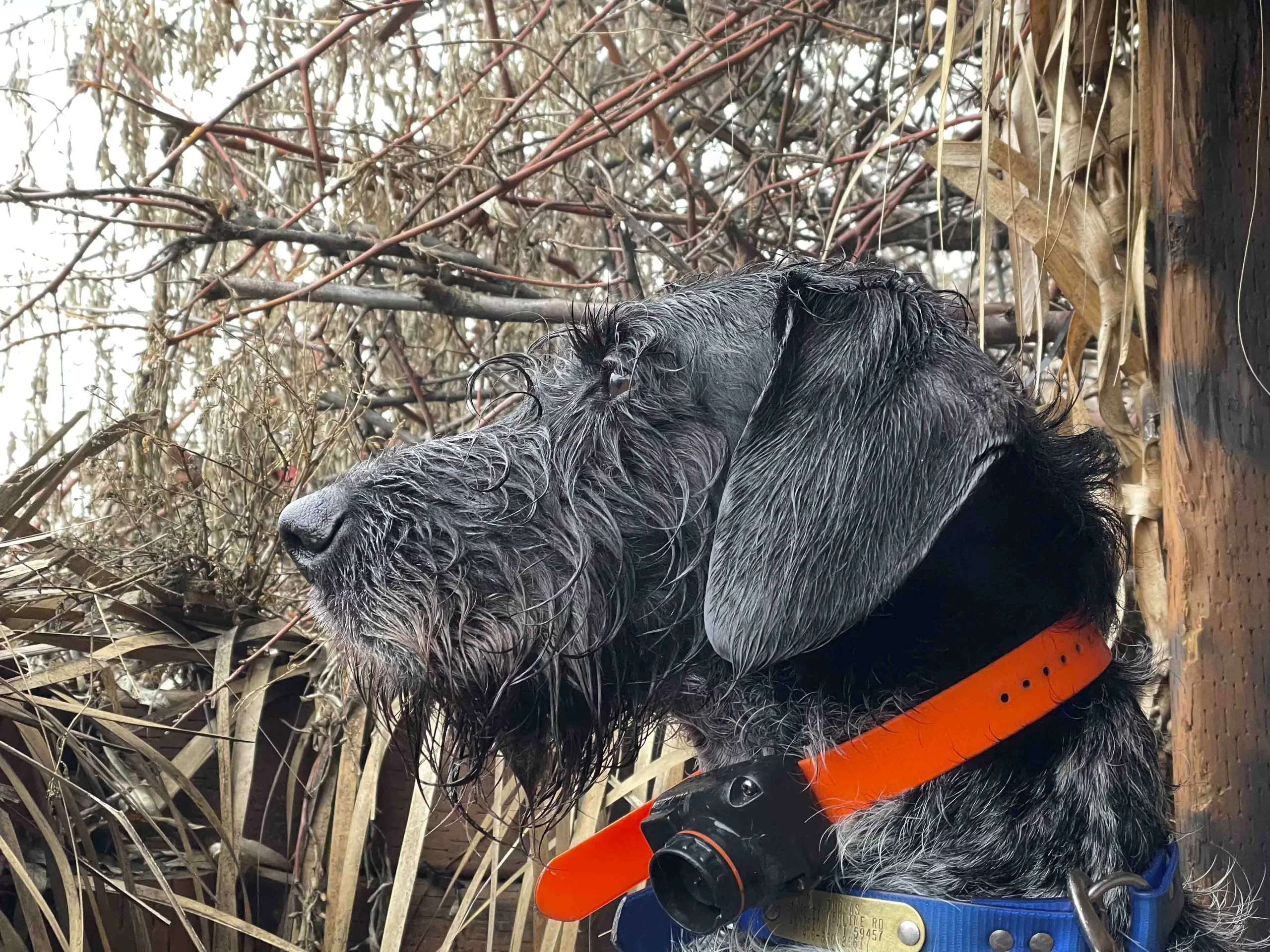The Versatile German Wirehaired Pointer – When Pointing Dogs Become Duck Dogs
By Don Thomas | Photos by Lori Thomas
This piece originally ran in the Fall 2021 Issue of Strung Sporting Journal, Titled “Our Water Rug” – it has been adapted for digital use.
“…in the catalogue ye go for men;
As hounds and greyhounds, mongrels, spaniels, curs
Shoughs, water-rugs and demi-wolves are clept
All in the name of dogs.
William Shakespeare, Macbeth, Act III, Scene I
German Wirehaired Pointer…in the Duck Blind?
I knew as soon as we finished setting out the decoys that December afternoon that we were about to enjoy a mallard shoot. During the late season in the Northwest, it’s not unusual to have a steady diet of northern greenheads appear uninterrupted over the decoys. Most duck hunters would write that development off as a nice problem to have, and I can’t blame them. Mallards, after all, are wary, challenging, large, and delicious. On the other hand, I have always enjoyed variety on waterfowl hunts even if that translates into nothing more than a few flocks of teal to remind me that I’m not as good a shot as the mallards made me think.
Before Lori and I could get ourselves organized inside the blind, I heard a chorus of distinctive mallard feeding chuckles overhead. After enduring several days of gray ice fog that rendered photography impossible, the gloom had lifted and left the marsh bathed in golden light. Unable to resist, Lori chose to leave her shotgun unloaded in favor of her camera, leaving the shooting to me, at least for the time being. I did not object.
The dogs—Rosy, our veteran female yellow Lab, and Max, the younger of our two German wirehairs—settled quietly onto the dog platform as mallards circled repeatedly without committing to the decoy spread. Of course, the first pair to drop in were hens, which we don’t shoot intentionally. Then one drake finally flew into range, or as we call it, the Circle of Death. When I rose and shot, it plopped down uneventfully just beyond the decoys.
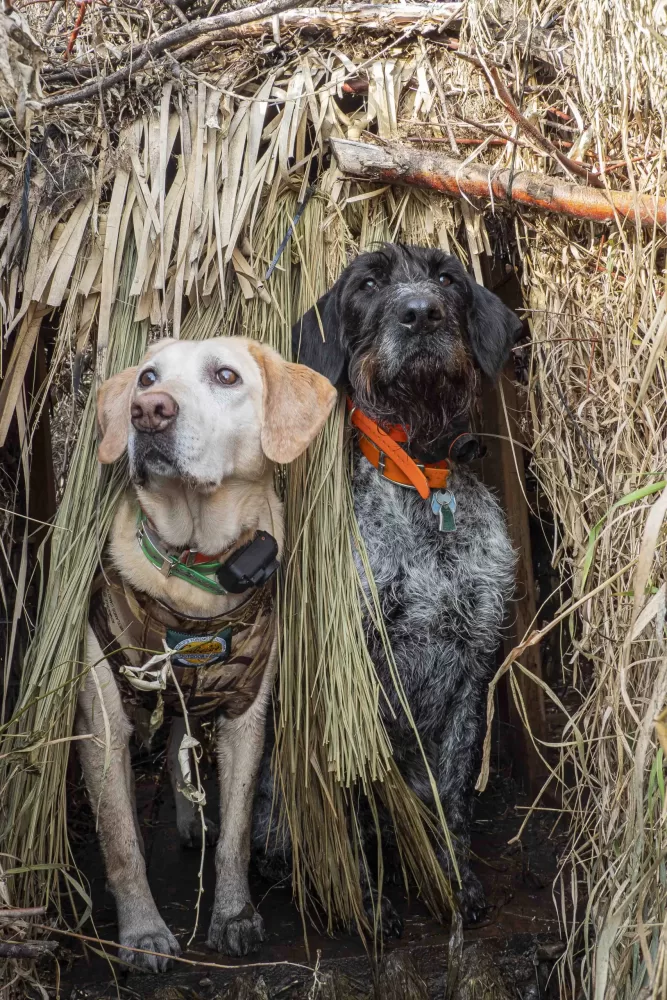
I really wasn’t surprised when Max broke and saved me from a difficult decision. With birds in the air all around us I might well have delayed the retrieve, but I was there for the dogs as much as the shooting. Rather than fretting over flaring birds and lost opportunities, I chose to enjoy watching Max charge through the decoys leaving curtains of sun-lit waterdrops suspended in his wake.
Max wouldn’t fit most hunters’ stereotypical image of a water dog. A large, powerful, handsome wirehair, he had served us well in upland cover as both a pointer and a retriever. We had taken him along on some duck hunts just for fun, but now we needed to expand his job description considerably because of some family drama in the kennel.
Rosy has been a terrific waterfowl dog but is now beginning to show her age, reminding me of the great tragedy inherent in the relationship between gun dogs and hunters—we live longer than they do. I now anticipated one or two more seasons with her at best. Maggie, our excellent female German wirehair, is heading to the geriatric wing as well. How she keeps hunting tough Montana pheasant cover as hard as she does at age twelve is beyond me, but I know that isn’t going to last forever either.
Recognizing this inevitable development, I had already begun to groom replacements for our two stalwarts. Max was meant to take over from Maggie in upland cover and was doing a fine job of it. I intended to replace Rosy with the young female Lab we’d named Kiska. That idea looked good on paper, but she proved to have one totally unexpected flaw: she hates the water. However, she hunted quite capably in upland cover and between her and Max I felt comfortable that we would be well served on dry land even without Maggie. I will credit Lori with the suggestion that we replace Kiska as Rosy’s understudy with Max, which turned out to be brilliant.
And why not? Max had already proven retrieving ability on sharptails and pheasants. As out of place as he might look in a duck hunting camp populated by Labs and an occasional Chessie, when we took him along with us occasionally during his first two seasons, he showed plenty of enthusiasm for water (and certainly more than Kiska did). Whatever rough edges he now showed in the duck blind were purely my own fault, since I’d poured all my waterfowl training energy into Kiska even though this now appeared to have been a lost cause. So, we resolved to spend our covid season duck hunting time with Rosy and Max.
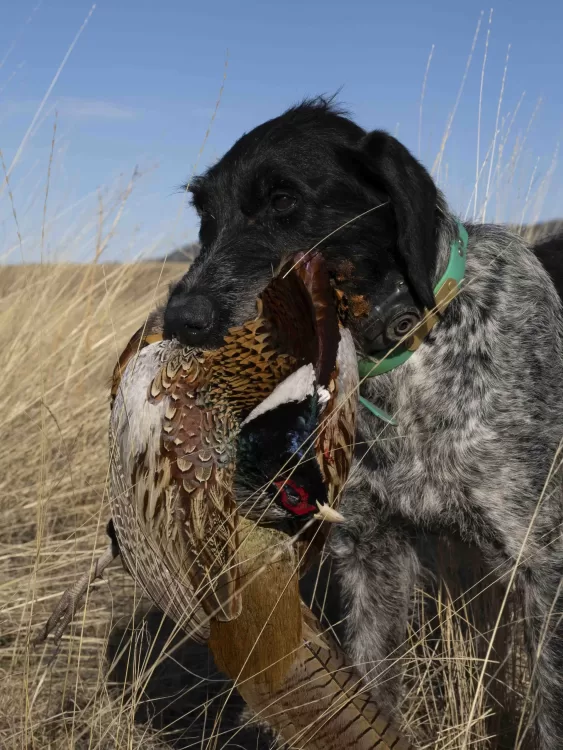
Shakespeare and Water Rug Dogs
One of the great pleasures of reading Shakespeare is discovering new language gems every time I re-read one of his plays (even the bad ones, and he did write some). I don’t know how many times I read Macbeth before I noticed the passage cited at the beginning of this piece and recognized it for what it was: a brief catalog of Elizabethan-era dog breeds. This insight should not have taken as long as it did. In a high school honors English class back in the 1960s, I wrote a well-received essay titled “Canine Imagery in King Lear,” and rode that pony all the way through years of English literature classes in college. Nowadays, someone would have stolen it, posted it on the Internet, and left me high and dry.
What really caught my eye during that moment of insight was the term “water-rugs.” Imagining Max emerging from a pond dripping wet with a mallard in his mouth, I could visualize exactly what Shakespeare had in mind. But what, exactly, was a water-rug? Usage of the term appears to be unique to Shakespeare, which is not unusual. The origins of dozens if not hundreds of Shakespearean terms appear to be without precedent and confound scholars to this day. What, for example, do the words “aroint” and “ronyon” mean? (Both appear in the same line from one of the Witches in Act I of Macbeth.) Such questions will likely provide fodder for doctoral theses for another four centuries.
After some investigation, I agreed with the consensus that Shakespeare was referring to the English water spaniel. We know he was aware of the breed, for in Act III, scene I of The Two Gentlemen of Verona, the character Launce refers to his love interest as having “more qualities than a water spaniel,” likely a comment on the breed’s versatility. Since neither the Irish nor the American water spaniel existed at the time, he must have been referring to the English version.
The English water spaniel, alas, is with us no more, the last known representatives of the breed having disappeared around 1930. It had a good, long run though, with written descriptions of the dog appearing as early as 1570, right before Shakespeare wrote Two Gentlemen, one of his earliest plays. The dog’s job description was right up our alley. Written in 1820, The Sportsman’s Repository advises that anyone interested in hunting waterfowl “had best use an English Water Spaniel.”
As nearly as I can tell, the breed disappeared simply because its enthusiasts were disorganized and more or less let it disappear by neglect. Its genetics probably live on however, in the American water spaniel, the flat coated retriever, and possibly others.
And, by way of Shakespeare, it has left me with a wonderfully idiosyncratic term for my German wirehair when he emerges from the water soaking wet. He really does look like a water-rug, whatever that might be.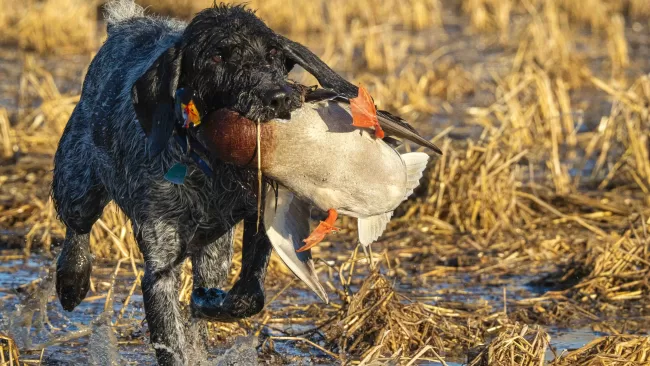
Dogs and Difficult Retrieves – How Does the German Wirehaired Pointer Fare?
One characteristic that has served to distinguish Rosy from so many of the other good Labs I have trained is her consistent ability to make really difficult retrieves—not just those on birds that have fallen at a distance, but the kind involving live birds, long ranges, obstructions, ice, thorns, and enough other complications to put the estimated probability of recovery in the snowball-in-hell category. Those aren’t jobs for dogs that are still learning, and I admit that during the first season Max began to accompany us on duck hunts I saved the tough stuff for Rosy, for three reasons. I didn’t want Max to get frustrated; I wanted Rosy to live out her final seasons in the glory she deserved; and I hate losing game.
On the afternoon in question, we had a half-dozen greenheads hanging on the duck strap before we got a break from our steady diet of mallards. The tearing silk sound that arose suddenly behind the blind was higher pitched and moving faster than anything I’d heard from mallards’ setting wings all afternoon. I knew the new arrivals were green-wings before I ever saw them, but that foresight provided no practical advantage. As is so often the case with teal, they were over the decoys and out of range before I could raise my gun.
Another characteristic of teal behavior, however, is their willingness to come back and take another look. When the flock performed an elegant high-speed turn a hundred yards in front of the blind, they gave me what I thought would be plenty of time to prepare for their second pass through shotgun range. Actually, “plenty of time” proved overly optimistic, for I never even thought about my second barrel.
Although my first shot connected, the bird hit the water swimming hard and immediately began a Michael Phelps sprint for the reeds on the far side of the pond. “I’d better send Rosy,” I said as I broke my gun.
“Let Max try,” Lori said. “He needs to learn sometime.” My wife has always served as Max’s principal advocate, both around the house and in the field. I suspect this is because she recognizes my special affection for Rosy and like any good mother wants all the kids to get their fair share of attention.
When I gave Max the command to fetch, Rosy began to express her disappointment, not through loud obnoxious whining but by whimpering softly as if her heart had been broken. “She’ll get over it,” Lori assured me as we watched Max charge across the pond. The water was shallow enough so that he could lunge faster than the wounded teal could swim, and he had marked the fall accurately. Of course, when dog met duck the wounded teal began to dive, and the real rodeo began.
Different dogs handle this difficult situation in different ways. One of my early Labs would dive completely underwater and remain submerged for frighteningly long lengths of time until he swam the duck down in its own element. He was barely more than a puppy the first time I saw him do that, and I was afraid that he had tangled himself up in some underwater obstruction and drowned until I saw him pop up 10 yards farther across the pond with the duck in his mouth. The dog had obviously maintained visual contact with the bird underwater. That trick wasn’t anything I taught him. It was simply the way he dealt instinctively with diving ducks, and I saw him do it repeatedly over the course of his long career.
The common problem for retrievers is simply losing track of the duck when it dives. Wounded ducks bring their own bag of tricks along to these contests between predators and prey. They usually change directions while underwater to throw the dog off-track, and when they surface, they swim with the lowest possible profile above water to make themselves hard to see. These maneuvers can drive even veteran dogs to distraction. Although I generally avoid setting inexperienced dogs up to fail by giving them difficult tasks, Lori was entirely right when she pointed out that Max was going to have to learn to deal with this situation eventually.
Overall, Max handled the challenge well, although he didn’t snag the duck until it had evaded him repeatedly. Standing up in the blind, I could see the duck more clearly than the dog could when it tried to swim off just below the water’s surface, with the tip of its bill tracing a delicate V across the surface. While Max’s handling wasn’t fine-tuned, he knew enough to turn in the general direction my arm indicated. The teal finally zigged when it should have zagged, and Max returned to the blind with the bird in his mouth and his head held as high as if he’d just won the Westminster Dog show.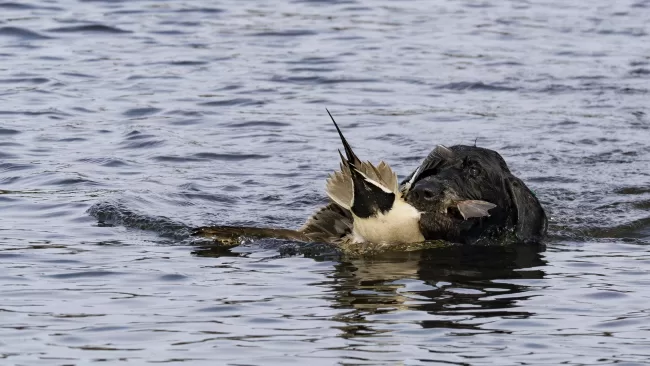 As the light level began to drop, Lori finally traded her camera for my shotgun. Her first shot produced a banded drake mallard, always a bonus on any duck hunt. Modern technology—the Fish and Wildlife Service duck band app on her cell phone—quickly informed us that the bird had originated in the Northwest Territories. Thanks to pandemic travel restrictions, that mallard had flown farther in 2020 than we had.
As the light level began to drop, Lori finally traded her camera for my shotgun. Her first shot produced a banded drake mallard, always a bonus on any duck hunt. Modern technology—the Fish and Wildlife Service duck band app on her cell phone—quickly informed us that the bird had originated in the Northwest Territories. Thanks to pandemic travel restrictions, that mallard had flown farther in 2020 than we had.
By the time we left the blind just before sunset, I was laboring under the weight of two Pacific Flyway limits, mostly greenheads supplemented by three green-wings. Both dogs seemed very happy, and I felt confident that Max, our water-rug, would be capable of taking over from Rosy when the time came.
Thinking Outside the Proverbial Duck Dog Box
A digression into the arcane world of Shakespearean scholarship may seem out of place in what is at heart a hunting story. However, the thesis of this piece is broader than either of those topics.
Duck hunters, like those who pursue any passion, tend to rely on the familiar while failing to appreciate the value of what lies outside the proverbial box. Ask a hundred waterfowl hunters to perform a quick word association test with the phrase “duck dog,” and 90-odd responses will likely be “Labrador retriever” (as would my own). You’ll hear about a few goldens from those who love the breed’s beauty, tractability, and utility in upland cover, along with a Chessie or two from folks who would probably own pit bulls if they didn’t hunt ducks. Any answers other than those drawn from the Big Three would definitely be outliers.
In fact, people have been hunting waterfowl with all kinds of dogs for centuries, starting long before Labs, goldens, and Chessies even existed, at least in their current form. The English water spaniel may no longer be with us, but its utility as a waterfowl dog was documented in word and art centuries ago. In addition to Max and other GWPs, I have personally hunted ducks with shorthairs, “English” pointers, and Brittanies. I once spent a pleasant morning in Alaska sitting in a rudely constructed blind with a friend and his Boykin spaniel. And then there is the rest of the pack, the retrievers about which we hear too little: American and Irish water spaniels, flat coats, curly coats, and others even more obscure. Interestingly, most of these breeds, in contrast to Labs, have coats that could qualify them as water-rugs.
Granted, most representatives of those alternate breeds with which I hunted didn’t perform as well in water as my better Labs, but most managed to provide good company and get the job done. We love the dogs we love, but that shouldn’t blind us to other possibilities.
Don Thomas, Strung’s managing editor, grew up in an outdoor family and has been hunting and fishing for nearly 70 years. He has spent his adult life in Montana and Alaska working as a rural physician, and has also been a pilot, commercial fisherman, and bear hunting guide. He has hunted and fished on five continents, written over 20 books on the outdoors, and continues to write for multiple magazines. His latest book, “On The Wing” is a reflection upon his 60 year experience hunting upland game birds and waterfowl. The text includes insightful observations on wildlife biology and habitat. It includes a lot of informative stories and information about hunting dogs, especially Labrador retrievers and various pointing breeds. While much of the material focuses on his current home state of Montana, settings also include Alaska, the desert Southwest, and Texas as well as international destinations such as New Zealand and multiple locations in Southern Africa. The text is supplemented by 45 high quality color photographs. Find out more and purchase his books at https://www.donthomasbooks.com/

